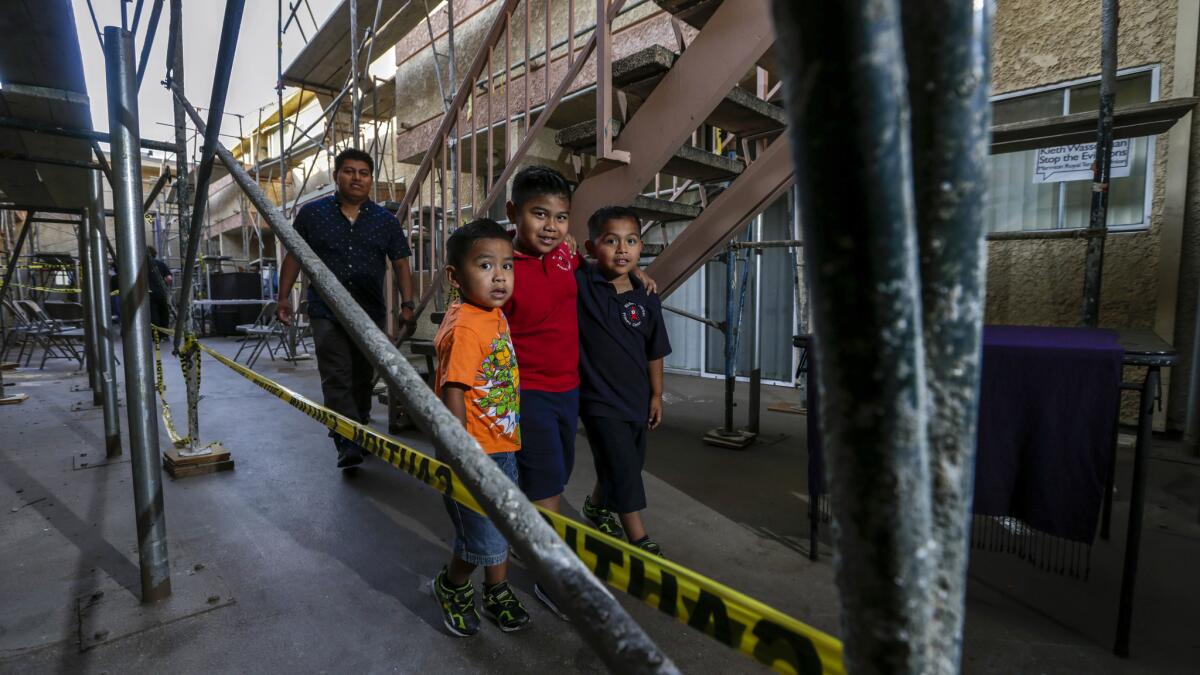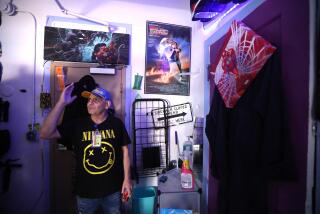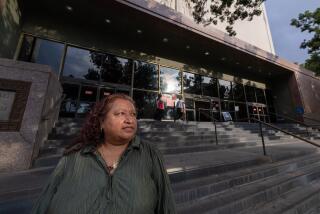Protesting tenants of a Highland Park apartment complex face a mass eviction

A late August confrontation outside the 60-unit Marmion Royal apartments in Highland Park marked a flashpoint in L.A.’s slow-burning drama over income inequality, cultural identity, housing affordability and neighborhood preservation.
The sandblasting contractor was in a bind. It was almost 9 a.m. and his crew was waiting for instructions. But the people wouldn’t leave.
They sat on folding chairs under his scaffolding, ate potluck offerings and danced to Cumbia music.
His boss, the stucco contractor, faced off with a leader of a group of tenants who say they have formed a union.
“We’re asking you in solidarity to move on to another site,” she said. “There’s plenty of other sites.”
“You’re stopping us from work,” he said. “We’ve got bills to pay too.”
She gave no ground.
“We’re going to mask the windows and we’re going to fire up the rig,” he said.
The late August confrontation outside the 60-unit Marmion Royal apartments in Highland Park marked a flashpoint in L.A.’s slow-burning drama over income inequality, cultural identity, housing affordability and neighborhood preservation.
With its rents and real estate prices rising dramatically in recent years, Highland Park has become the latest front in the wave of gentrification that has swept nearby communities such as Echo Park and Atwater Village, uprooting working-class Latinos from neighborhoods they have called home for decades.
“Highland Park is now ground zero, not only in L.A., but in the whole country,” said Peter Dreier, professor of urban and environmental policy at Occidental College in Eagle Rock.
“Hedge funds and private equity firms are gobbling up properties all over the country,” he said. “They buy buildings for speculation. There’s enormous pressure on landlords to get rid of tenants.”
In the first half of this year, 20 multi-family buildings changed hands in Highland Park, five more than the same period last year, according to the real estate data firm CoStar.
Many of those buildings are rent-controlled, limiting raises to 3% a year and requiring owners to pay relocation fees to anyone evicted for renovations.
But Marmion Royal was built in 1987, years after the city’s Rent Stabilization Ordinance went into effect, making the apartment complex exempt.
When a new owner began renovating units and asked to negotiate higher rents, tenants saw it as a move to force out longtime low-income residents. They banded together and demanded de facto rent control — long-term leases with limited increases.

“They’ve stood up,” said John Urquiza, a freelance photographer and designer who organizes for an anti-gentrification group called the North East Los Angeles Alliance. “That’s a lot different from what’s been going on, people negotiating their way out and retreating.”
Skya Ventures, a Tarzana investment company, bought the complex in May from Azusa Pacific University. The university had acquired the property as a donation and remained a distant landlord, allowing rents and maintenance to lag.
The boxy, two-building complex was no beauty on the outside. But at $14.3 million — and free of city rent controls — it was full of potential.
A Gold Line station is across the street, and the long-sleepy North Figueroa Street business district, which sits a block away, is stirring with trendy restaurants catering to Highland Park’s burgeoning influx of urban professionals.
Skya planned to upgrade the apartments and bump up the rents 50%, said the firm’s management agent, Chris Gray. The idea was a gradual renovation, allowing tenants to re-lease a few at a time as vacant units were refurbished, Gray said.
For Rudy Rosales, a 50% increase would be the same as an eviction notice. A cook who works double shifts in West Hollywood, Rosales lives with his children, ages 3, 5 and 7, in a one-bedroom apartment costing $1,000 a month.
Rosales said he had turned down a move into a two-bedroom unit because he couldn’t afford the $1,500 rent.
Tenants contend Skya has negotiated with only the few white and well-off families in the complex.
Gray disputes the contention. He said he attended a tenant meeting and asked all present to contact him.
“The only people we have negotiated with are people who have approached us,” Gray said.
One of those, Marmion Royal resident Hannah Weinstein, a Pasadena labor lawyer, said she met with Skya just to see what was on the table.
The landlord offered to rent her a two-bedroom unit for more than $2,600 a month, Weinstein said, “but they told us to please negotiate.”
The price was eventually dropped to $2,100, an increase of just over 50% over her current rent, but Weinstein wasn’t taking.

“We see ourselves as part of the union,” she said. “We want our neighbors to stay in the neighborhood they’ve lived in all their lives.”
In late June, guided by a tenant advocates group called the Eviction Defense Network, residents declared their intention to withhold rent until Skya met their condition to re-lease to them under the terms of rent control.
As a show of good faith, they are holding cashiers’ checks for each month’s rent.
Since then, the tenants’ union had been engaged in an escalating tit-for-tat with Skya and its management over piecemeal evictions, pest infestations and the scheduling of repair work.
The tension erupted in late August over sandblasting. Workers set up scaffolding along the outside walls and reduced the two-tone, beige-and-sandstone finish to a base of gray stucco.
Tenants complained that even with the windows masked, their homes were penetrated by dust, aggravating health conditions.
Then the workers erected steel and wood plank walkways in the narrow courtyard of one building and notified residents they would have to stay indoors or leave the building from 10 a.m. to 3 p.m. on four consecutive days.
The tenants asked to be relocated to a hotel during the sandblasting. Gray said Skya offered rent credits to individuals who had identified health problems. But the tenants wanted Skya to deal with all of them equally.
On Aug. 29, a picket line of mostly men blocked the gated entrance on Marmion Way. Police arrived and warned the tenants that they could be arrested for preventing the workers from entering the building. By then the sandblasting crew had left.
Urquiza, the tenant organizer, came up with a new strategy: Instead of facing off with the workers, the tenants would throw a party.
The next morning, they were waiting when Gilbert Nuñez, owner of Elite Sandblasting in of Monte, arrived with his truck and crew to play an elaborate bluff that would shortly be called.
“We bid the job; I’m here to complete it,” Nuñez told two women who met him on the sidewalk.
Out front, a smartly dressed woman walked the sidewalk with a cellphone to her ear.
She was Gelena Skya-Wasserman, founder and owner of Skya Ventures.
As the crew began unrolling high-pressure hoses, Skya-Wasserman aimed the cellphone at an anti-Skya sign the tenants had hung above the courtyard entrance.
Two young women on the stairs gave her looks.
“Take my picture,” one said, striking a modeling pose.
“You can give me the middle finger,” Skya-Wasserman said. “That’s OK.”
The ice was broken. Ten minutes later, Skya-Wasserman was sitting in a folding chair in the courtyard surrounded by stony-faced young men, women with infants in their arms and toddlers playing under the scaffolding.
She tried to show empathy.
“I respect where you are coming from,” she said at one point. “I respect your needs. To whatever extent I can get it, I get it.”
But the tenants’ positions remained hardened.
“What’s important to say, if you’re not paying rent, nothing can be negotiated,” Skya-Wasserman concluded.
By then the sandblasting crew had pulled down the masking and reeled in the hoses.
Nuñez said he called the sandblasting off.
Later in the day, a process server arrived and handed out 60-day “no fault” eviction notices to many of the remaining tenants, a procedure that is legal in non-rent-controlled buildings.
Gray, Skya’s agent, said the move was planned and had not resulted from the day’s confrontation.
Urquiza called it an escalation.
The next night the tenants met in the nearby All Saints Episcopal Church. Urquiza rallied those who were shaken by the mass eviction.
Elena Popp, the tenants’ lawyer, assured them that the earliest they could be summoned to court would be January.
If they stuck together, and kept putting their deposits into the trust account, they could win, she said.
At the end of the night, they reached a consensus to stick together and be ready the next morning for the return of the sandblasters.
On Thursday morning, the courtyard was more crowded than before with supporters in solidarity from the L.A. Tenants Union, Union de Vecinos of Boyle Heights, North East Los Angeles Alliance and even Occidental Students United Against Gentrification.
The sandblasters didn’t show.
“We’ve won the day,” Urquiza told the tenants. “But we have to keep our vigilance up.”
Since then, the outside walls have been painted, the scaffolding has been removed without sandblasting and several tenants have received unlawful detainer notices, beginning the court process to evict them.
Twitter: @latdoug
ALSO
Massive L.A. coroner backlog comes at a price for loved ones of those lost
NRA not putting up much of a fight against California gun control ballot measure
Suspect in Palm Springs police killings had body armor and high-capacity magazines, authorities say
More to Read
Sign up for Essential California
The most important California stories and recommendations in your inbox every morning.
You may occasionally receive promotional content from the Los Angeles Times.











